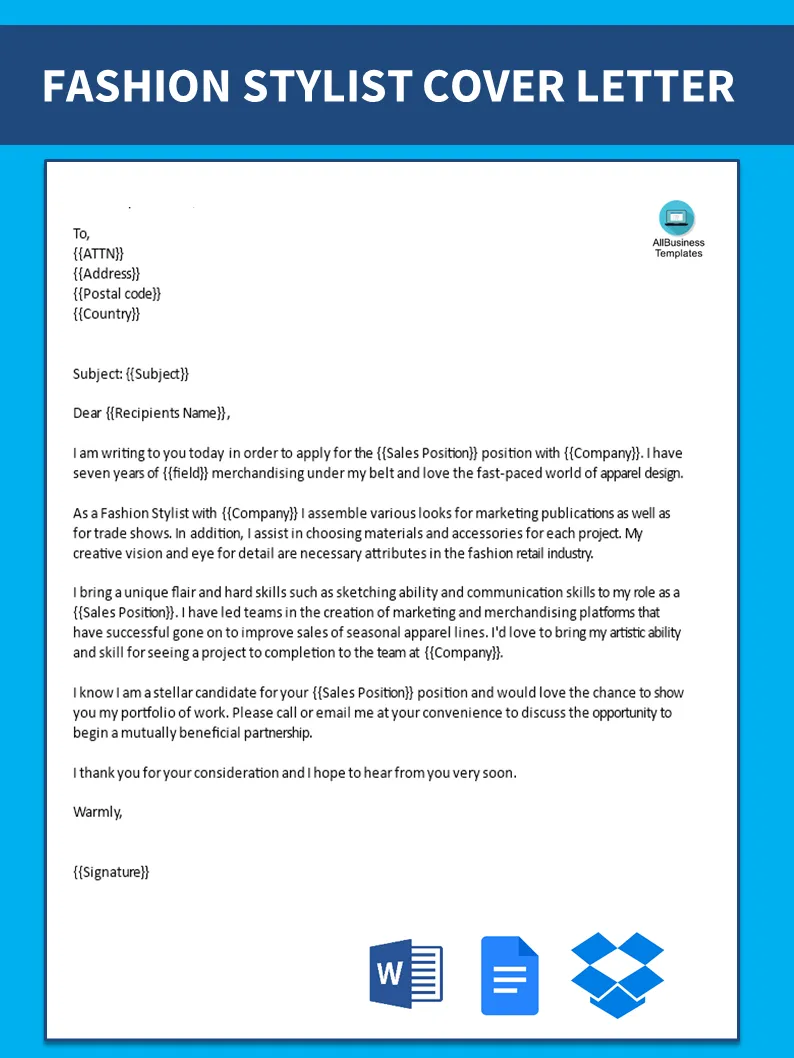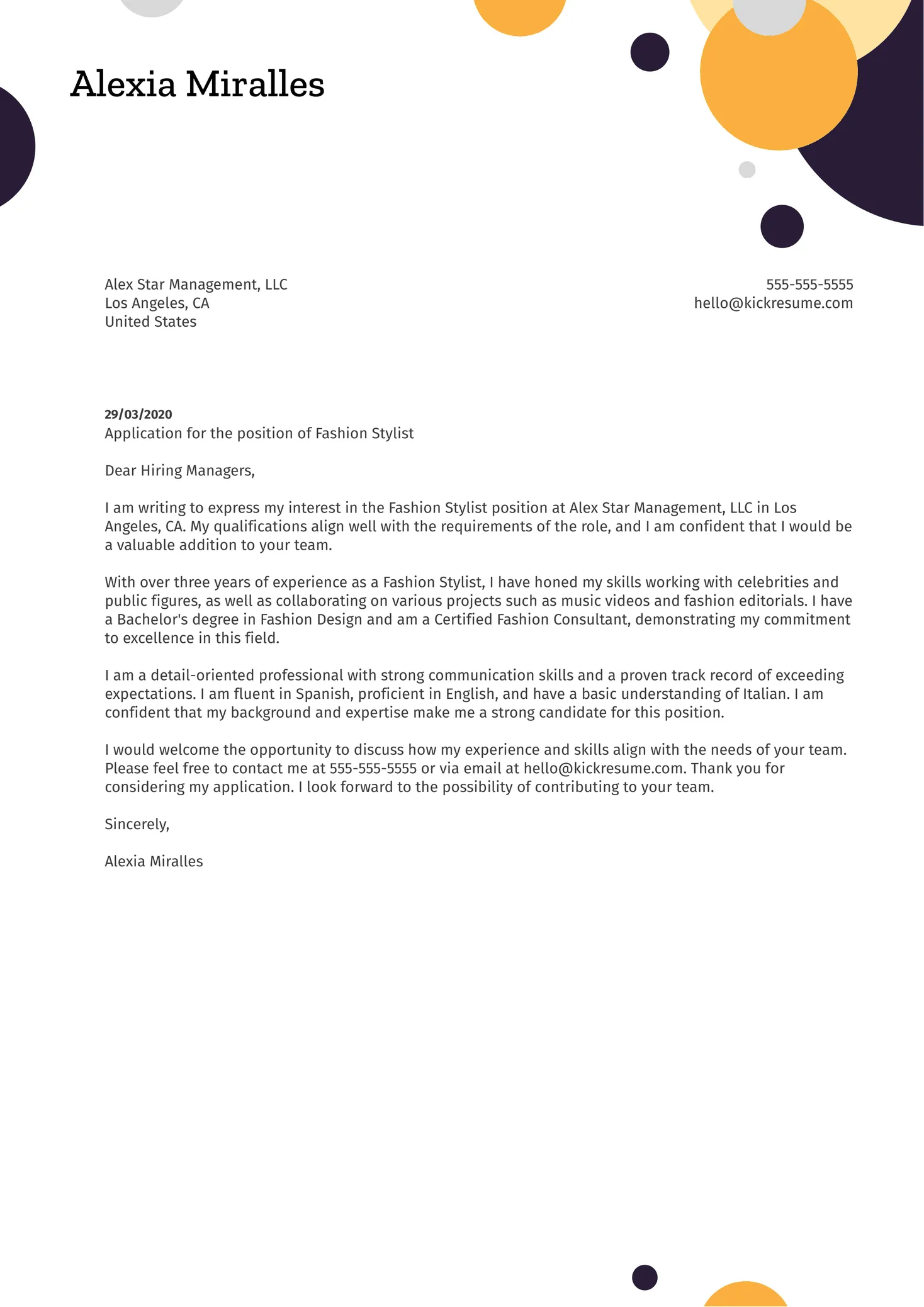Understanding the Fashion Stylist Role
Before diving into the cover letter, it’s crucial to understand what a fashion stylist does. A fashion stylist is responsible for selecting clothing and accessories for a variety of projects, including photoshoots, runway shows, personal styling, and editorial features. They work to create a specific look or image, considering factors such as the client’s or project’s needs, current trends, and overall aesthetic. The role requires creativity, strong visual skills, knowledge of fashion history and trends, and the ability to work under pressure. Even if you have no direct experience, understanding the core responsibilities helps you tailor your letter to showcase your potential and passion for the field. This includes knowing about current fashion trends.
Key Skills for Fashion Stylists
Fashion stylists need a diverse set of skills. These include creativity, attention to detail, excellent communication, and the ability to work well under pressure. They should have a strong understanding of fashion trends, designers, and brands. They also need strong organizational and time-management skills to handle multiple projects and meet deadlines. Another crucial skill is the ability to build and maintain relationships with clients, photographers, designers, and other industry professionals. You can include research skills about upcoming trends.
Highlighting Transferable Skills

If you lack direct experience as a fashion stylist, focus on transferable skills. These are skills you’ve gained from previous jobs, volunteer work, or personal projects that are relevant to the role. For instance, experience in retail can demonstrate customer service and sales skills. Any experience in visual merchandising can show your ability to create appealing visual displays. Even roles that require a degree of creative flair like graphic design or photography can highlight your visual communication capabilities. List these transferable skills in the cover letter, providing specific examples of how you’ve used them. Also, mention any project or experience that aligns with the role. This should be in the form of your skills and why you are a good fit for the role.
Crafting a Compelling Cover Letter
A compelling cover letter is essential. It should grab the reader’s attention from the start and provide a clear and concise overview of your qualifications. Remember, the purpose of your cover letter is to get an interview, so it should be persuasive and tailored to the specific job. It should make you stand out and be seen as the best candidate. Highlight your passion for fashion, showcase your skills and explain why you are interested in the role and the company. Also make sure that your cover letter is easy to read. Make sure the cover letter is unique. Don’t copy templates, and also tailor the letter for the job.
Formatting Your Cover Letter
The format of your cover letter can significantly impact its readability. Use a professional font like Times New Roman or Arial in a 12-point size. Maintain consistent formatting throughout the document, including the same font, margins, and spacing. Include your contact information at the top, followed by the date, the hiring manager’s name (if known), and the company’s address. Divide your cover letter into logical sections, such as an introduction, a body, and a conclusion. Keep your paragraphs concise, and use bullet points to emphasize key skills or accomplishments. Make sure the text is easily readable.
Writing a Strong Opening

Your opening paragraph is your first chance to make a great impression. Start with a strong statement that grabs the reader’s attention. State clearly the position you are applying for and where you found the job listing. Show your enthusiasm for the role and the company. Avoid generic phrases such as “I am writing to express my interest.” Instead, try something like, “I am writing to express my enthusiasm for the Fashion Stylist position at [Company Name].” If you know someone working at the company, mention their name to increase the chances of getting the job. State why you are interested in the role, and what you can offer the role and the company. Show your understanding of the job and the company.
Showcasing Your Enthusiasm
Demonstrate your passion for fashion and styling throughout your cover letter. Use enthusiastic language to convey your interest in the role and the industry. Talk about your favorite designers, your style influences, or any personal projects that show your commitment to fashion. If you have a strong interest in a particular area of fashion, like sustainability or streetwear, make sure to mention this. This shows that you have real interest in the job, and can work for the job. Do not be afraid to show how interested you are in the role and the fashion industry. Your enthusiasm will make you stand out, especially if you do not have the required experience.
Demonstrating Research and Knowledge
Show that you’ve researched the company and the role. Mention specific aspects of the company or its work that you admire. Tailor your cover letter to match the job description’s requirements. You can also showcase your knowledge by referring to specific trends, designers, or fashion events that align with the company’s brand. Doing research shows your interest and allows you to include information that will make you more suitable to the role. Do your research on the company, and also the job itself.
Focusing on Your Strengths

Even without direct experience, you have strengths that make you a good candidate. Identify these strengths and emphasize them in your cover letter. These can include skills, such as creative thinking, attention to detail, or strong organizational capabilities. Provide examples of how you’ve used these strengths in other contexts. For example, if you’re organized, you can mention a time you successfully managed a large project, whether in a work setting or personal. Do not be afraid to add all the strengths that you think are suitable for the job.
Highlighting Relevant Experiences
Even if you haven’t worked as a fashion stylist, you likely have relevant experiences. This could include volunteer work, personal styling projects for friends, or participation in fashion-related events. If you’ve helped a friend put together an outfit, describe the process and the results. If you’ve volunteered at a fashion show, mention the skills you used and the experience gained. Quantify your achievements whenever possible. For example, “Styled five models for a local fashion show.” Add any work experience that could relate to the role.
Addressing the Lack of Direct Experience
It’s important to address the lack of direct experience in a positive way. Instead of apologizing for your lack of experience, focus on your enthusiasm and transferable skills. Frame your lack of experience as an opportunity. You can also highlight your willingness to learn and grow. Express your eagerness to take on new challenges and adapt to the fast-paced environment of the fashion industry. Highlight all the courses or training that you have taken. Reassure the hiring manager that you are a fast learner, and a good fit.
Including a Portfolio or Examples

A portfolio is a must-have for aspiring fashion stylists, especially if you lack experience. Create a digital portfolio showcasing your styling work, even if it’s just personal projects or collaborations. Include photos of outfits, mood boards, and any visual concepts you’ve created. If you do not have a portfolio, consider doing some styling projects and photographing the results. Include links to your portfolio in your cover letter and resume. If you cannot create a portfolio, you can always describe the work that you did. Add links to your work, if any.
Tailoring Your Letter to the Job
Always tailor your cover letter to each job you apply for. Read the job description carefully and identify the key skills and requirements. Adjust your cover letter to highlight the skills and experiences that match the job requirements. Customize your letter by mentioning the company’s values, mission, or recent projects to show that you understand the role. Make it unique, and don’t use a template.
Proofreading and Editing
Proofreading and editing are critical. Ensure your cover letter is free of grammatical errors, typos, and spelling mistakes. These errors can detract from your professionalism and undermine your credibility. Read your cover letter aloud to catch any awkward phrasing or sentence structure. Ask a friend or family member to review your cover letter for a fresh perspective. The document should be polished and professional.
Making a Strong Closing

End your cover letter with a strong call to action. Thank the hiring manager for their time and consideration. Reiterate your enthusiasm for the role and company. Express your availability for an interview. Provide your contact information, including your email address and phone number. Make sure your closing statement is clear and concise, and make the hiring manager want to contact you.
Following Up After Submission
Following up is a professional practice. If you do not hear back within a week or two after submitting your application, it’s okay to follow up. Send a brief, polite email to the hiring manager. Reiterate your interest in the role. Ask about the status of your application. This shows that you are truly interested in the job. Remember, a well-written cover letter can significantly increase your chances of getting hired, even without experience.
